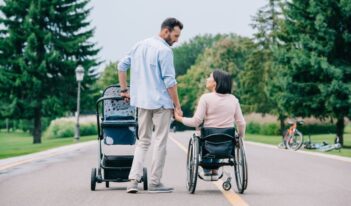
Experts offer analysis and policy ideas to promote the independence and well-being of older adults.
The Administration for Community Living (ACL) is a subdepartment of the U.S. Department of Health and Human Services that is dedicated to the health and well-being of older adults. Earlier this month, ACL published a notice announcing its objective to update regulations adopted under the Older Americans Act (OAA) for the first time in 35 years.
The ACL developed its proposed rule changes in response to a May 2022 formal request for information from the public as well as several listening sessions with older adults. The agency sought to implement rules that would better advance the desire of older adults to live independently and remain integrated in their communities.
Signed into law in 1965 and reauthorized in 2020, the OAA requires states and Native American tribes to construct aging plans that use federal funds to promote healthy aging. The programs sponsored by the OAA include home-delivered meals, transportation, legal assistance, and caregiver support.
The ACL’s proposed updates to regulations adopted under the OAA outline the role of state agencies and area agencies on aging (AAAs) in ensuring that funds are used for the benefit of older Americans with the “greatest economic needs.” The ACL’s proposal would also aim to clarify expectations of objectives about what should be included in states’ aging plans. It also describes the need to improve caregiver support programs, increase the nutritional value of home-delivered meals, and implement elder abuse prevention initiatives. These changes could improve older Americans’ quality of life and reduce barriers to their independence.
A recent survey revealed that 88 percent of aging individuals in the United States prefer to receive assistance in their home or in a loved one’s home. When explaining their preference for remaining in their homes as they age, senior citizens cited concerns about losing their independence, loneliness, meeting their social needs, and safety.
Maintaining self-autonomy while ensuring community ties has been shown to improve the well-being of older individuals because, as they experience loss in mobility, chronic pain, or a decline in their socioeconomic status, they need a support system to help mitigate the stressors associated with aging. Housing and health care costs, however, present an obstacle for older individuals to remain in their communities and live independently or with family members.
Currently, the Biden Administration’s 2024 budget includes $150 billion dedicated to expanding Medicaid home care services for seniors and people with disabilities. In addition, the Administration pledged to support caregivers and help recruit others to the profession.
Advocates of updating rules adopted under the OAA argue that government programs must be capable of addressing the health and housing needs of a growing elderly population. In particular, these advocates call for the prioritization of older adults with the greatest economic and social needs. In 2020, a government study found that by 2030, adults age 65 and over will represent 21 percent of the United States population, increasing to 73 million from 52 million people in 2018. Furthermore, that same study indicated that life expectancies across all genders and race or ethnicities in the United States have increased.
In this week’s Saturday Seminar, The Regulatory Review summarizes the work of scholars and advocates who offer varying perspectives on addressing the health, housing, and overall well-being of older adults.
- In an article in Health Affairs, Terry Fulmer and coauthors caution that the U.S. health care system is unprepared to care for a growing older population. According to Fulmer and her coauthors, the current fragmentation of care requires federal leadership to enact regulatory and legislative changes. Fulmer and her coauthors identify six vital actions necessary to improve the care and quality of life of all older Americans. Fulmer and her coauthors recommend strengthening the role of public health by creating a healthy aging program at the Centers for Disease Control and Prevention (CDC). If federal officials address this issue proactively, they could create an infrastructure that promotes better health and equitable, goal-directed care that better recognizes and fulfills the preferences and needs of older adults, concludes Fulmer and her coauthors.
- In an article published in the Journal of Aging and Social Policy, Marc A. Cohen and Jane Tavares of the LeadingAge LTSS Center at University of Massachusetts Boston demonstrate how current eligibility standards exclude financially and medically vulnerable older adults from Medicaid coverage. Cohen and Tavares explain that the income limit, calculated using the federal poverty level, does not account for health expenses, cost-of-living variations across states, nor changes in expenditure patterns over time. Furthermore, Cohen and Tavares note that the asset limit component has not been adjusted since 1989. After Cohen and Tavares analyzed the effects of five alternative financial eligibility standards, they found that older adults who would be covered under four out of five of the alternative standards are as financially and medically vulnerable as those covered under existing standards. Cohen and Tavares emphasized the importance of reexamining eligibility criteria as the Biden Administration seeks to improve health care access to older adults.
- In an article published in BMC Geriatrics, Mary Beth Arensberg and her coauthors analyzed states’ OAA aging plans for inclusion of nutrition terms such as malnutrition, sarcopenia, frailty, and obesity. The authors found that nutrition terms were rarely mentioned in states’ policy goals. Although 87 percent of state aging plans included the term “nutrition” as an action item, malnutrition was mentioned in only 15 percent of the plans and obesity in only 2 percent. According to the authors, their findings demonstrate states’ lack of attention to nutrition-related conditions in older adults, especially concerning body composition, muscle mass, and mobility. The government’s implementation of OAA must establish a tailored definition of nutrition to ensure that states incorporate nutritional goals in aging plans and implement nutrition screening, Arensberg and coauthors recommend.
- Reforms to Section 8 housing programs are necessary to reduce the stressors on low-income older adults, MaryAllison Mahacek suggests in an article in the Elder Law Journal. The administration of Section 8 vouchers is an obstacle to securing housing for low-income older adults because landlords and tenants are discouraged from moving forward after the burdensome paperwork, Mahacek argues. She recommends that public housing agencies that administer the voucher program should be given authorization to experiment with the amount of funding available and help craft tenant-landlord protocols. This administrative change, Mahacek suggests, would grant tenants more purchasing power as vouchers would need to reflect their income level and local cost of living. Furthermore, landlords would not be discouraged by the regulations imposed on them, she argues. Empowering older adults to choose where they want to live would increase their happiness, safety, and independence as they navigate the effects of aging, Mahacek concludes.
- Area agencies on aging have played a crucial role in addressing the changing needs of older adults due to the COVID-19 pandemic, argues Haley B. Gallo and Kathleen Wilber of the Leonard Davis School of Gerontology at the University of California in an article in The Gerontologist. Gallo and Wilber explain that under the OAA, area agencies are positioned in a unique way to create informal community partnerships and leverage supplemental fundings sources. In the context of service network shutdowns that impacted older adults during the pandemic, Gallo and Wilber describe how the agile structure of area agencies on aging enabled them to mobilize already-existing community partnerships, form new partnerships to meet demands, and apply flexible funding. Gallo and Wilber warn, however, that area agencies’ demonstration that they can thrive on limited funding may make them vulnerable to funding cuts if the U.S. enters another recession.
- The elderly population requires protections of rights that go beyond statutory construction, argues Jessica Garcia-Brown of Nova Southeastern University Shepard Broad College of Law in an article in the Cardozo International and Comparative Law Review Journal. Garcia-Brown finds that the elderly population has historically been underrepresented in policies aimed at providing protections to vulnerable or marginalized communities. Many countries outside the United States have universal healthcare systems that provide varied forms of care for the elderly while the U.S. healthcare framework for older individuals remains in its infancy, according to Garcia-Brown. Garcia-Brown recommends that, as the elderly population in the U.S. increases, the use of international charters as a model for creating uniform legislative protections that would protect the elderly.
The Saturday Seminar is a weekly feature that aims to put into written form the kind of content that would be conveyed in a live seminar involving regulatory experts. Each week, The Regulatory Review publishes a brief overview of a selected regulatory topic and then distills recent research and scholarly writing on that topic.



